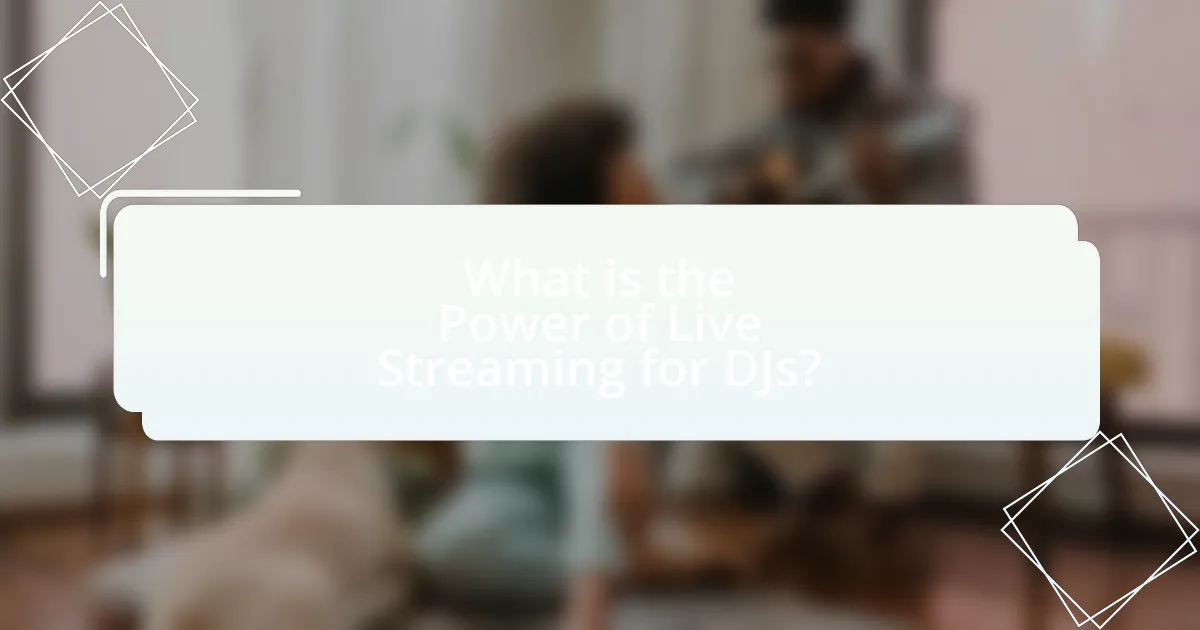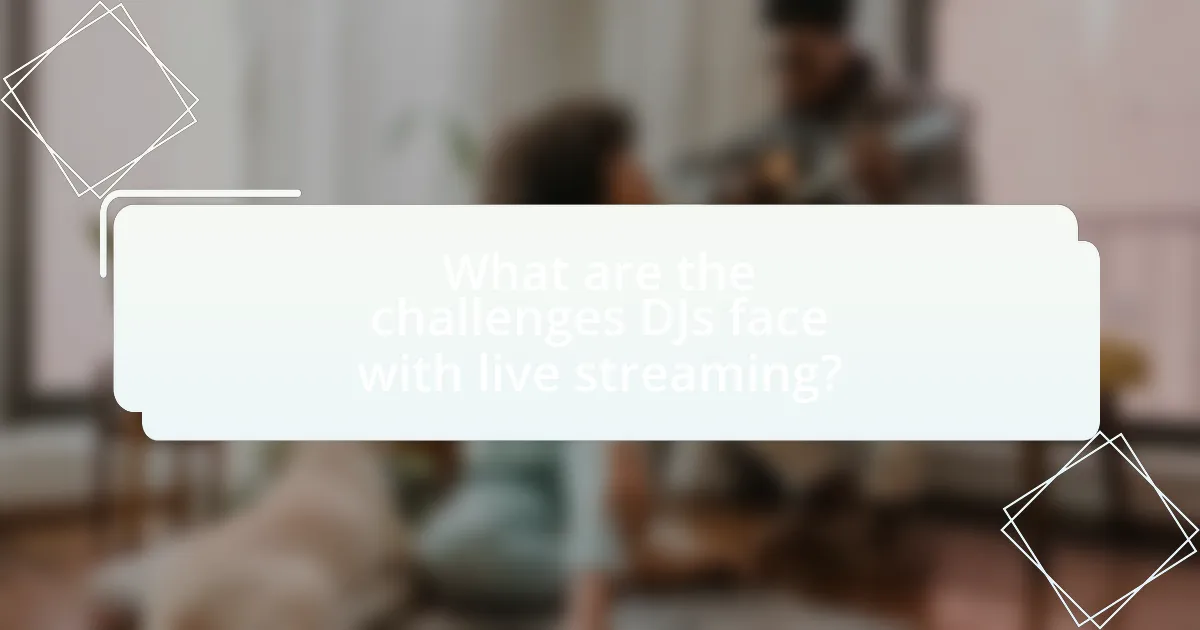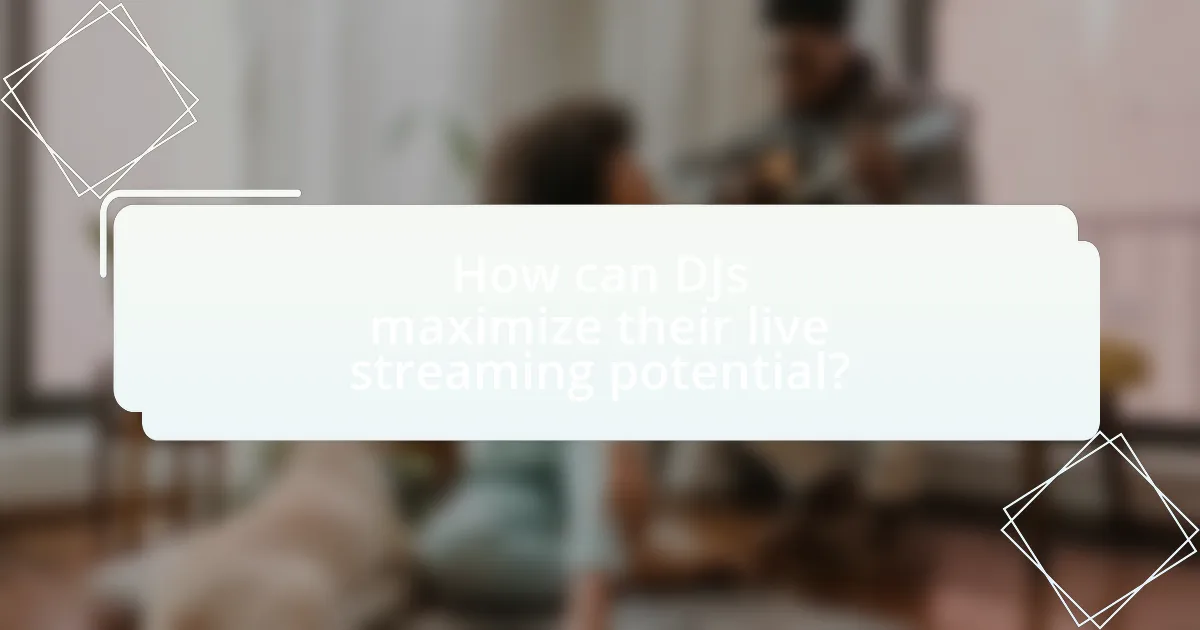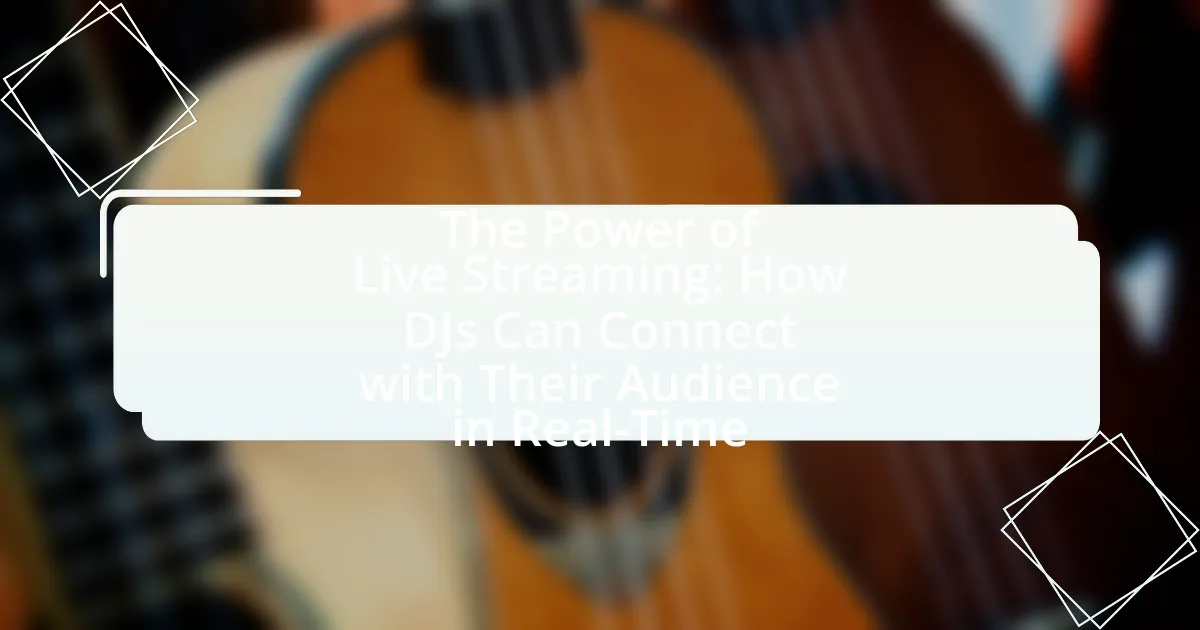The article focuses on the power of live streaming as a transformative tool for DJs to connect with their audiences in real-time. It explores how live streaming enhances engagement, expands reach, and allows for immediate feedback, thereby fostering a sense of community among fans. Key technologies essential for effective live streaming, the impact of different platforms, and the importance of real-time audience interaction are discussed. Additionally, the article addresses challenges DJs face, including technical issues and copyright concerns, while providing strategies for maximizing their live streaming potential and creating engaging content.

What is the Power of Live Streaming for DJs?
The power of live streaming for DJs lies in its ability to create real-time connections with audiences, enhancing engagement and expanding reach. Live streaming allows DJs to perform for global audiences, breaking geographical barriers and enabling interaction through chat features, which fosters a sense of community. According to a report by Statista, the global live streaming market is projected to reach $247 billion by 2027, indicating a growing trend that DJs can leverage to increase their visibility and fan base. This interactive platform not only allows for immediate feedback but also enables DJs to showcase their unique styles and music selections, thereby solidifying their brand in a competitive industry.
How does live streaming enhance the DJ experience?
Live streaming enhances the DJ experience by allowing DJs to reach a global audience in real-time, creating an interactive and immersive environment. This technology enables DJs to perform live sets from anywhere, engaging with fans through chat features and social media integration, which fosters a sense of community. According to a report by the International Music Summit, live streaming events have seen a 50% increase in participation since 2020, demonstrating its effectiveness in connecting artists with audiences. Additionally, platforms like Twitch and YouTube Live provide tools for audience interaction, such as polls and requests, further enriching the live experience for both DJs and listeners.
What technologies are essential for effective live streaming?
Essential technologies for effective live streaming include high-quality cameras, reliable microphones, encoding software, and stable internet connections. High-quality cameras ensure clear video, while reliable microphones capture crisp audio, both critical for engaging viewers. Encoding software, such as OBS Studio or Wirecast, compresses and formats the video for streaming platforms, ensuring compatibility and quality. A stable internet connection, ideally with high upload speeds, prevents buffering and interruptions, maintaining a seamless experience for the audience. These technologies collectively enhance the overall quality and reliability of live streaming, making them indispensable for DJs connecting with their audience in real-time.
How do different platforms impact the live streaming experience?
Different platforms significantly impact the live streaming experience by influencing audience engagement, accessibility, and technical performance. For instance, platforms like Twitch and YouTube offer interactive features such as chat and real-time feedback, enhancing viewer participation and connection. In contrast, platforms like Facebook Live may prioritize reach over engagement, affecting how audiences interact with content. Additionally, technical aspects such as video quality, latency, and user interface vary across platforms, which can affect the overall viewing experience. Research indicates that platforms with lower latency, such as Twitch, provide a more seamless experience, allowing for immediate interaction between DJs and their audience, thereby fostering a stronger connection.
Why is real-time audience connection important for DJs?
Real-time audience connection is crucial for DJs because it enhances engagement and creates a dynamic atmosphere during performances. This connection allows DJs to read the crowd’s reactions and adjust their set accordingly, ensuring that the music resonates with the audience. Studies show that live interactions can increase audience satisfaction and loyalty, as participants feel more involved and valued. For instance, a survey by Eventbrite found that 78% of attendees prefer events where they can interact with performers, highlighting the importance of real-time connection in fostering a memorable experience.
How does audience interaction influence a DJ’s performance?
Audience interaction significantly enhances a DJ’s performance by creating a dynamic feedback loop that influences song selection, energy levels, and overall engagement. When DJs observe audience reactions, such as dancing, cheering, or even the use of social media interactions, they can adjust their set in real-time to maintain or elevate the crowd’s energy. For instance, a study by the University of Southern California found that live audience feedback can lead to a 30% increase in audience satisfaction when DJs adapt their performances based on crowd responses. This adaptability not only fosters a more immersive experience but also strengthens the connection between the DJ and the audience, ultimately leading to a more memorable event.
What role does feedback play in live streaming sessions?
Feedback plays a crucial role in live streaming sessions by enabling real-time interaction between DJs and their audience. This interaction allows DJs to gauge audience reactions, adjust their performance accordingly, and enhance viewer engagement. For instance, immediate feedback through chat or reactions can inform DJs about song preferences, energy levels, and overall audience enjoyment, leading to a more tailored and immersive experience. Research indicates that real-time feedback significantly increases viewer satisfaction and retention rates during live streaming events, demonstrating its importance in fostering a strong connection between performers and their audience.
What are the key benefits of live streaming for DJs?
The key benefits of live streaming for DJs include increased audience reach, enhanced engagement, and the ability to generate revenue. Live streaming allows DJs to connect with fans globally, breaking geographical barriers and attracting larger audiences than traditional in-person events. Enhanced engagement occurs through real-time interaction, where DJs can respond to comments and requests, fostering a sense of community. Additionally, DJs can monetize their streams through ticket sales, merchandise, and sponsorships, creating new revenue streams that are not typically available in physical performances. These benefits collectively empower DJs to expand their brand and maintain a strong connection with their audience.
How does live streaming expand a DJ’s reach and audience?
Live streaming expands a DJ’s reach and audience by allowing them to perform in real-time to a global audience, transcending geographical limitations. This technology enables DJs to connect with fans from various locations simultaneously, increasing their visibility and potential fan base. For instance, platforms like Twitch and YouTube Live have reported millions of concurrent viewers for popular DJ streams, showcasing the vast audience that can be engaged through live streaming. Additionally, live streaming often incorporates interactive features such as chat and real-time feedback, further enhancing audience engagement and fostering a sense of community among fans.
What opportunities does live streaming create for collaboration?
Live streaming creates significant opportunities for collaboration by enabling real-time interaction between DJs and their audience, as well as among DJs themselves. This format allows DJs to collaborate on performances, share techniques, and engage with fans through live chats and social media integration, fostering a sense of community. For instance, platforms like Twitch and YouTube Live facilitate joint streams where multiple DJs can perform together, enhancing their reach and audience engagement. Additionally, live streaming allows for immediate feedback from viewers, which can inform collaborative decisions and improve future performances.
How can DJs effectively engage their audience during live streams?
DJs can effectively engage their audience during live streams by incorporating interactive elements such as real-time polls, shout-outs, and responding to chat messages. These strategies foster a sense of community and participation, making viewers feel valued and involved. For instance, a study by the International Journal of Music Business Research found that live interaction significantly increases viewer retention and satisfaction during online performances. By actively involving the audience, DJs can create a more immersive experience that enhances connection and enjoyment.
What strategies can DJs use to promote their live streaming events?
DJs can promote their live streaming events by leveraging social media platforms, creating engaging content, and collaborating with influencers. Social media platforms like Instagram, Facebook, and Twitter allow DJs to reach a broad audience quickly; for instance, 73% of marketers believe that their efforts through social media marketing have been “somewhat effective” or “very effective” for their business (Buffer, 2021). Engaging content, such as behind-the-scenes videos or teaser clips, can generate excitement and anticipation among fans. Collaborating with influencers or other artists can also expand reach, as partnerships can introduce DJs to new audiences, enhancing visibility and engagement.

What are the challenges DJs face with live streaming?
DJs face several challenges with live streaming, including technical issues, audience engagement, and copyright concerns. Technical issues such as poor internet connectivity can disrupt the stream quality, leading to a frustrating experience for both the DJ and the audience. Audience engagement is also a challenge, as DJs must find ways to interact with viewers in a virtual setting, which lacks the immediate feedback of a live audience. Additionally, copyright concerns arise when DJs play music that is not licensed for streaming, risking potential legal repercussions. These challenges highlight the complexities DJs must navigate to successfully connect with their audience in real-time through live streaming.
How can technical issues affect a live streaming performance?
Technical issues can significantly disrupt a live streaming performance by causing interruptions, reducing audio and video quality, and leading to viewer disengagement. For instance, a poor internet connection can result in buffering, which interrupts the flow of the performance and frustrates viewers. Additionally, audio glitches or video lag can diminish the overall experience, making it difficult for the audience to connect with the DJ. According to a study by Streamlabs, 70% of viewers reported that technical difficulties negatively impacted their enjoyment of a live stream. These disruptions can lead to a loss of audience engagement and potential revenue for the DJ, highlighting the critical importance of reliable technology in live streaming.
What are common technical problems DJs encounter during live streams?
Common technical problems DJs encounter during live streams include audio quality issues, connectivity problems, and equipment malfunctions. Audio quality issues often arise from poor sound mixing or inadequate microphones, leading to distorted or unclear sound. Connectivity problems can occur due to unstable internet connections, resulting in lag or interruptions during the stream. Equipment malfunctions, such as software crashes or hardware failures, can disrupt the performance and affect the overall experience for viewers. These challenges are frequently reported by DJs and can significantly impact the effectiveness of live streaming as a medium for audience engagement.
How can DJs prepare for potential technical difficulties?
DJs can prepare for potential technical difficulties by conducting thorough equipment checks and having backup gear readily available. Ensuring that all audio and visual equipment is functioning properly before a performance minimizes the risk of failure during a live stream. Additionally, DJs should familiarize themselves with their software and hardware, as well as have a contingency plan, such as a secondary internet connection or a mobile hotspot, to maintain connectivity. According to a survey by DJ TechTools, 70% of DJs reported that having backup equipment saved them from technical issues during performances, highlighting the importance of preparation.
What are the legal considerations for DJs when live streaming?
DJs must consider copyright laws, licensing requirements, and platform regulations when live streaming. Copyright laws protect the rights of music creators, meaning DJs need to obtain licenses for the tracks they play to avoid infringement. Organizations like ASCAP, BMI, and SESAC provide performance licenses that cover public performances, including live streams. Additionally, streaming platforms often have their own rules regarding music usage, which can include content identification systems that may mute or remove streams containing unlicensed music. Failure to comply with these legal considerations can result in penalties, including fines or account suspension.
How do copyright laws impact music played during live streams?
Copyright laws significantly impact music played during live streams by requiring streamers to obtain licenses for any copyrighted music they use. Failure to secure these licenses can result in legal consequences, including fines and the removal of content. For instance, the Digital Millennium Copyright Act (DMCA) mandates that platforms like Twitch and YouTube enforce copyright protections, leading to potential takedowns of streams that violate these laws. Additionally, organizations such as ASCAP and BMI manage performance rights, meaning DJs must pay fees to use copyrighted music legally during their live performances.
What licenses do DJs need for live streaming their performances?
DJs need performance licenses and synchronization licenses for live streaming their performances. Performance licenses are required to legally play copyrighted music in public, which includes streaming platforms. These licenses can be obtained from performing rights organizations such as ASCAP, BMI, or SESAC. Synchronization licenses are necessary when a DJ mixes or edits music for a live stream, as they cover the rights to use the music in conjunction with visual content. Without these licenses, DJs risk copyright infringement, which can lead to legal consequences.

How can DJs maximize their live streaming potential?
DJs can maximize their live streaming potential by utilizing high-quality audio and video equipment, engaging with their audience through real-time interaction, and promoting their streams effectively across social media platforms. High-quality equipment ensures a professional sound and visual experience, which is crucial for retaining viewers. Engaging with the audience through chat or live Q&A sessions fosters a sense of community and connection, enhancing viewer loyalty. Additionally, promoting streams on platforms like Instagram, Facebook, and Twitter can significantly increase visibility and attract a larger audience, as evidenced by a 2021 report from Statista showing that 54% of live stream viewers discover content through social media.
What best practices should DJs follow for successful live streaming?
DJs should ensure high-quality audio and video, engage with their audience, and promote their streams effectively for successful live streaming. High-quality audio is crucial because poor sound can deter viewers; using professional equipment and a stable internet connection can enhance the listening experience. Engaging with the audience through live chats or social media interactions fosters a sense of community and connection, which is essential for viewer retention. Additionally, promoting streams in advance through social media platforms and email newsletters increases visibility and attendance, as evidenced by studies showing that pre-event marketing can boost viewer numbers significantly.
How can DJs create engaging content for their live streams?
DJs can create engaging content for their live streams by incorporating interactive elements, such as live Q&A sessions, polls, and real-time requests from viewers. These strategies foster audience participation and enhance the overall experience. For instance, a study by the Interactive Advertising Bureau found that 70% of viewers prefer content that allows them to engage directly with the creator, indicating that interactivity significantly boosts viewer retention and satisfaction. Additionally, DJs can enhance their streams by showcasing behind-the-scenes content, sharing personal stories, or collaborating with other artists, which can create a more intimate connection with the audience.
What tools can enhance the live streaming experience for DJs?
To enhance the live streaming experience for DJs, essential tools include high-quality audio interfaces, professional-grade microphones, and video streaming software. High-quality audio interfaces, such as the Focusrite Scarlett series, ensure superior sound quality by minimizing latency and providing clear audio output. Professional-grade microphones, like the Shure SM7B, capture vocals and ambient sounds with clarity, enhancing the overall audio experience for viewers. Video streaming software, such as OBS Studio or Streamlabs, allows DJs to create visually engaging streams by integrating multiple video sources, overlays, and effects, which can significantly improve audience engagement. These tools collectively contribute to a more immersive and professional live streaming experience for DJs.
What are some tips for troubleshooting common live streaming issues?
To troubleshoot common live streaming issues, first ensure a stable internet connection with a minimum upload speed of 3 Mbps for standard quality and 5 Mbps for HD streaming. Next, check the streaming software settings to confirm that the correct video and audio sources are selected. Additionally, monitor CPU usage; high usage can lead to lag or dropped frames, so close unnecessary applications. If viewers experience buffering, consider lowering the stream quality or switching to a wired connection. Lastly, test the stream before going live to identify and resolve any potential issues. These steps are essential for maintaining a smooth live streaming experience.

Leave a Reply